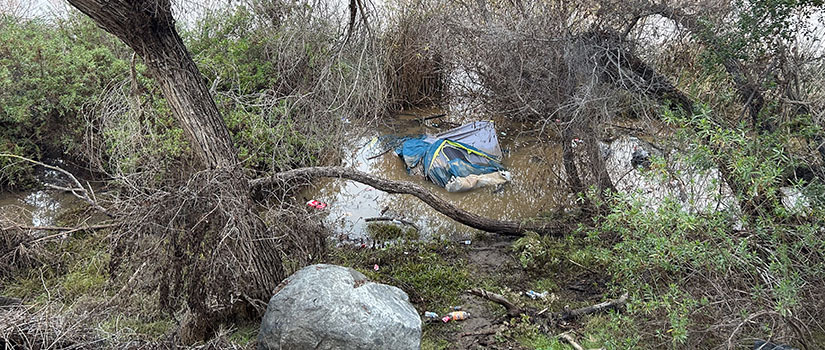Pictured above: Previously someone's home, a tent floats in the San Diego River after heavy rains caused flooding.
The homelessness rate in the U.S. has risen steadily since 2017. With over 171,000 people lacking consistent housing, California has by far the highest number of homeless people. Since the state is also prone to natural disasters, homeless people in California are particularly at risk.
To help alleviate this issue, Civil and Environmental Engineering Assistant Professor Erfan Goharian is developing a system to protect this displaced population safe from flooding.
“Homeless communities are already vulnerable, and they are more exposed to natural disasters,” Goharian says. “We wanted to combine our technology and research to help with a social problem.”
Funded by the National Science Foundation’s Smart and Connected Community grant, the project aims to create a system of cameras that will be constantly monitored by artificial intelligence to immediately warn homeless communities of flooding. Goharian has collaborated with researchers from San Diego State University to deploy a pilot program along the San Diego River. The team plans to conserve valuable resources by automating a process that currently uses a significant amount of manpower.
“Artificial intelligence means that whatever we can do, computers and machines should be able to do it if they are trained well,” Goharian says. “We don’t want a person to sit and look at cameras 24/7 because the machine can do that.”
Along with Goharian, Computer Science and Engineering Professor Yan Tong is developing a deep learning model that can analyze images of water to forecast flooding. Tong’s model will collect data, such as water depth from the camera system. In addition, San Diego State Associate Professor Hassan Davani is using computer modeling to identify flood-prone areas.
The data will be used to create a network of cameras that will monitor the most vulnerable places. The final product will not only be able to predict flooding but also estimate evacuation time to help outreach programs allocate their resources more effectively.
“We want to know what the actual needs are rather than guess,” Tong says. “We are not the people affected the most, but we can help the people working with the [homeless] community.”
The project will enter its second year of development this fall. Goharian’s team have spent the first year determining the needs of the community and building a deep learning model. The group aims to optimize materials by taking advantage of existing resources like the area’s traffic camera system.
“We want to place the cameras very strategically. Having more cameras doesn’t necessarily mean getting more or better information,” Goharian says.
Goharian and Tong have created an in-house camera system that can analyze images onsite, making operations quicker and cheaper. Meanwhile, Professor Megan Welsh Carroll from the San Diego State University School of Public Affairs focuses on community outreach by helping develop a framework to distribute weather warnings among homeless populations. The team is also collaborating with local outreach organizations, People Assisting the Homeless, and the San Diego River Foundation. The research team wants to spend as much time engaging with the community as possible.
“We want to make sure that any action we take is informed by scientists and engineers, but ultimately community-driven,” Goharian says. “Instead of sitting in our offices and thinking about solving hypothetical problems, we want to make sure that the problems we are solving are real.”
While the research has been promising so far, Goharian expects the project to last four-to-six years. The next step is to work towards an extension of the grant funding for the second phase of the project.
The researchers are hopeful about the implications of the system they are creating. Goharian plans to bring his work back to South Carolina and develop a similar infrastructure to help the local homeless population. According to Tong, their deep learning model may also be used with drones to predict the spread of wildfires or crop diseases.
“It’s a different process, but it involves similar technology. This is wild thinking, but the techniques may be applicable,” she says.
While homelessness remains a pressing issue in the U.S., the research team is committed to doing their part.
“The health of the most vulnerable individuals matters. If the poorest and most marginalized folks can be kept safe, that says a lot about the good things in our society,” Carroll says.
Goharian emphasizes that engaging with the community is essential for conducting research that truly makes a difference.
“We read the news and identify problems scientifically, but going out and talking to people, that’s when you realize the extent of the problem,” Goharian says. “Feeling, experiencing and seeing the problem is something that all academic people should do.”
